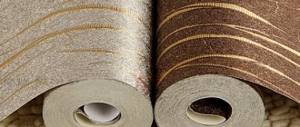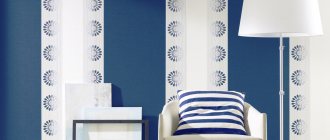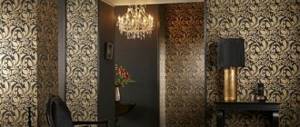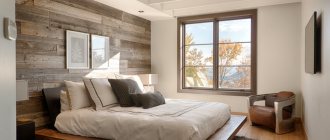What wallpaper can be painted
The renovation is done, the walls are covered with wallpaper, a crucial moment comes, on which the overall impression of the interior of the room will depend. It is important to know what paint should be used to paint wallpaper and how to apply it correctly to the surface, whether it is possible to change the color of a previously painted surface.
The base and coating of the material have different technical characteristics, which determine how many times the walls can be repainted and the duration of operation of such a finish.
Classification of wallpaper for painting:
- Paper wallpaper impregnated with a waterproof compound that allows it to be painted. Two-layer types are suitable for painting; thin material can get wet and peel off from the wall.
- Vinyl wallpaper is available in regular and paintable versions. Before painting, you need to pay attention to the markings on the label.
- Non-woven wallpaper is suitable for repeated painting. They cost more, but due to the fact that the material will not need to be re-glued after a few years, they pay for themselves during operation.
- Fiberglass wallpaper has increased strength and is made from environmentally friendly raw materials. Glass fiber threads are applied to a paper base. They can be painted with water-dispersion, latex and acrylic paints up to 20 times. Easy to glue, but difficult to remove from the surface. Withstands washing with a brush. Produced specifically for painting.
- "Linkrust" wallpaper coverings are made by applying a composition of rosin, wax, chalk and wood flour to a textile or paper base. After setting with the surface, the coating acquires high strength.
It is convenient to apply the paint with a roller.
In order not to spoil the volumetric texture of non-woven wallpaper, they cannot be painted with heavy paints or compositions based on aggressive solvents.
Is it possible not to paint wallpaper before painting?
The wallpaper is pasted, the room immediately sparkles with new colors: it seems larger, neater, cleaner. And the first thought after gluing is to leave everything as it is, because the room already looks perfect. Is it possible to do this?
It’s difficult to answer unequivocally, since some nuances play a role:
- glass wallpaper is the most durable among other types. Their top layer is already protected from the ubiquity of external unfavorable factors: sunlight, moisture and other things that can cause damage to the coating;
- Other types of wallpaper, especially paper, have a thin top layer, which will quickly wear out without additional protection.
Therefore, it is better to cover wallpaper for painting with paint, it can even be the same tone as the coating. This will ensure their preservation for many years.
Related article: Fire retardants: which paint is best to use?
Advantages of wallpaper for painting
Painting wallpaper with your own hands is a simple type of construction work that does not require special skills.
Advantages of painting wallpaper:
- After time has passed, in order to update the interior, you do not need to re-paste the wallpaper, just paint it.
- The opportunity to create a unique interior. You can paint the surface one color or a combination of several shades.
- The surface can be wiped with a damp cloth, unless it is painted with a water-based composition.
- Damaged, dirty areas can be painted over using the same shade.
It is much easier and faster to paint a surface than to remove the old coating and stick new wallpaper.
Wallpapering for painting: tools and materials
How to organize wallpapering so as not to spoil its appearance? This question worries everyone, since often in order to save the budget one has to refuse the services of specialists. Under no circumstances should wallpaper be wiped with a regular rag, as was done when using old wallpaper. It is very important that the process does not cause any damage to the embossing.
Wallpapering tools
9 main materials and tools come to the rescue:
- Soft and elastic brush;
- Paint roller;
- Glue;
- Additives for coloring;
- Paints;
- Construction tape;
- Stationery knife;
- Putty knife;
- Acrylic primer.
Please note that the glue used for this work should be applied exclusively to the wall. This will not only save material consumption, but also simplify the work process. If you apply glue to the wallpaper, the texture may peel off and it will not be possible to save the material.
Related article: How to use lemon to get rid of scale in a kettle?
Non-woven wallpaper is convenient because if an error was made during gluing, it can be corrected by simply pulling the edge of the material. Such manipulations can stretch the tape and control all imperfections.
Paint selection
The quality of the surface and its appearance will depend on the correct choice of paint. Before painting the wallpaper, you need to purchase all the necessary consumables.
The paint is chosen depending on the wallpaper material and the operational characteristics of the room:
| № | Type of wallpaper | Dye |
| 1 | Paper | Water-based is made from two types of liquids that do not mix with each other. The thinner is white spirit. The surface painted with this composition cannot be washed, as the coloring matter will be washed off from the surface. |
| 2 | Non-woven | Water-dispersion paint is resistant to moisture. The diluent is water. |
| 3 | Vinyl | Water-based or acrylic. |
| 4 | Fiberglass wallpaper | Latex and acrylic paints are suitable for use in rooms with high humidity; the surface can be washed. |
In rooms with windows facing south, it is better to use latex paint compositions; they do not fade under the influence of sunlight, but we must not forget that after opening the package the composition hardens within several hours.
Classification of paints by reflective ability:
- Glossy compounds form a shiny film on the surface, making the room seem lighter. To obtain a jacquard effect, glossy paint is applied to the matte surface with a sponge.
- Matte paint does not reflect light well, making the room appear less lit. Using a matte composition you can mask small surface defects.
- Satin coloring compositions have a moderate shine and are durable. Suitable for use in kitchens and bathrooms.
What paint to paint the wallpaper needs to be decided depending on many factors. It is easiest to apply water-based compositions to the surface. Acrylic paint is universal and retains its properties for a long time.
How to hang wallpaper for painting
For this type of wallpaper, a perfectly smooth surface is not necessary, but the walls must still be prepared: cleaned and dried. These wallpapers are glued end to end. It is important that after painting the joints are practically invisible. The main thing is to choose the appropriate glue, paint and apply these compounds correctly.
When working with the paper version of wallpaper for painting, glue is spread directly onto the canvas. In the case of non-woven wallpaper, the adhesive is applied to the surface of the wall, and then the canvas is applied to it.
To reliably fix wallpaper for painting, which most often belongs to the “heavy” group, it is advisable to use ready-to-use acrylic adhesives rather than dry adhesive mixtures soluble in water. If you use regular glue and dilute it in the wrong proportion (and it’s not that difficult to make a mistake), the canvas may subsequently peel off at the edges.
How to calculate paint consumption
Before painting wallpaper, you need to correctly calculate how much paint you will need. It is mainly sold white, to obtain the desired shade, the entire volume of the composition is mixed with the color. If there is not enough paint, it will be difficult to maintain proportions to get the same color.
What you need to know to calculate paint consumption:
- absorbency of the material;
- paint consumption per m2 is indicated on the label;
- surface area to be painted.
To determine the area, you need to multiply the length by the width of each wall, subtract the area of windows and doors. Add up the obtained indicators for each surface.
The average paint consumption is about 180 g per m2 if painted in one layer, and 250 g per m2 when painting wallpaper in two layers. The composition must be purchased with a reserve of 10-20%.
What is paintable wallpaper?
This type differs from traditional external wall coverings in its voluminous coarse-fiber or embossed structure. Sweeping drawings, as a rule, are absent. This pattern allows you to use your imagination and experiment with how to paint wallpaper for painting. Photos with examples can be seen in various design magazines and in this article.
The advantage of such wallpaper is that each subsequent layer is cheaper compared to the cost of purchasing a new roll of material and gluing it.
Many buyers are interested in how to paint wallpaper for painting if a certain color has already been applied to it. Experts say that this material is designed for 5-15 layers of coating. When changing wallpaper, you can simply dismantle the old ones by removing them from the wall.
Wallpaper painting tool
Many people wonder how to paint wallpaper before painting, with a roller or brush. A roller will be needed to process smooth surfaces, and with a brush it is easy to cover hard-to-reach places and corners.
Types of rollers and the effect that can be achieved when using them:
| № | Type of roller | Resulting surface |
| 1 | Foam rubber | If you lightly touch smooth walls, uncolored bubbles will form on the surface. |
| 2 | Long nozzle | Will deeply color textured wallpaper. |
| 3 | Short nozzle | Suitable for painting walls with wallpaper with a relief pattern; it can be used to emphasize the texture of the surface. |
An interesting texture on the surface can be created using a textured roller.
To paint wallpaper you will need a special paint tray.
Which roller to use to paint wallpaper: a roller with a small pile absorbs paint well and allows you to distribute it evenly over the surface.
How to glue and paint wallpaper for painting
Categories: Articles
Paintable wallpaper has gained great popularity over the last decade. This is an excellent solution for those who do not like monotony, because the color can be updated at will. These wallpapers can subtly highlight the details of the interior and add zest to it.
Many people want to try paintable wallpaper, but don’t know where to start. However, if you look into all the details, the idea of using wallpaper for painting becomes even more attractive. A huge selection of options makes the selection process easier.
Painted wallpaper has sound-absorbing properties, creates comfort in the room, and helps protect walls from scratches and damage.
DIY wallpaper painting
How to properly paint wallpaper for painting, the main stages of the technological process:
- After wallpapering, the surface must dry completely, this will take 1-3 days.
- Remove or cover furniture and other household items. Cover the floor with plastic film to protect it from paint.
- All joints with baseboards, door frames, cornices and other elements that need to be protected from paint are sealed with wide masking tape.
- Painting wallpaper with water-based paint requires diluting it with color until the desired tone is obtained.
- The paint is most often sold in white. To obtain the required shade, colors are added to it. You can mix several pigments to achieve the desired color. Stir the composition in a bucket or other container. Do a test on a piece of wallpaper. Pour a small amount of the mixture into the tray.
- We paint the wallpaper in one go. If you carry out painting in several stages, then transition points will be noticeable on the surface at the junction of strips that were applied at different times.
- First, apply the composition with a brush to corners, joints and other hard-to-reach places. After this, paint is applied over the entire surface with a roller in vertical stripes from top to bottom. Start working from the window. Make sure that there are no unpainted areas left.
- When applying the composition in several layers, each subsequent layer is applied after the previous one has dried.
Options for coloring fiberglass rolls.
The use of a spray gun allows you to obtain a uniformly painted surface and speeds up the work process. Since there is no friction on the wall, the possibility of repainting increases several times.
Most often, it is enough to apply the dye in two layers. When diluting a composition with a color yourself, you need to take into account that the shade on the surface will be lighter than it appears in the container.
How to properly glue wallpaper for painting
In order for the work to be organized correctly, you need to know exactly where the gluing begins.
You can start gluing wallpaper from anywhere. However, most people follow tradition, starting from a corner or from a window.
Most often it starts from the corner of the room. To make the process of measuring and cutting less time-consuming, you can prepare several strips at once.
In order to determine the size, be sure to use a construction tape, and only then cut the canvas into strips.
First thing to do. This is to lubricate the hay with glue, and only then stick the wallpaper. Whether to wait time before applying or not, this will be answered by the instructions for the purchased glue. You only need to level the material with a roller or brush. Never use a rag as this may ruin the appearance.
Article on the topic: Design of a veranda for a dacha: photos and projects of summer terraces
Forget about the overlap method, this method is a thing of the past. This type of wallpaper is glued exclusively end-to-end. If glue gets on the material, it must be removed immediately, since untimely cleaning will leave a permanent imprint. After the work is completed, you will need to wait time for drying.
Walls that are dry are easier to paint, but what color you choose depends on personal preference. Once the paint is applied to the surface, you will have a seamless surface with beautiful color.
Adviсe
How to properly paint wallpaper for painting so that it does not lose its performance characteristics:
- Before painting the wallpaper, you need to check the intensity of the shade on a small sample.
- The walls are painted after the ceiling; if done in the reverse order, the composition from the ceiling can get onto vertical surfaces and form streaks.
- The container with the coloring composition is opened immediately before performing work; if this is done in advance, the composition may harden.
- Latex paint hardens within a few hours. You need to apply it to the walls quickly so that the entire composition is consumed during this time.
- To restore the color of previously painted wallpaper, a composition of the same shade is applied to it.
- How to repaint wallpaper to be painted in a lighter shade: to obtain a lighter tone compared to the previous one, first apply a layer of white paint and then the composition of the selected color.
- Non-woven wallpaper can be painted on both sides. First, paint the back side, wait until it is completely dry. Wallpaper is glued and after it has completely dried, the outside is painted.
Stylish bedroom design.
When painting, it is important not to saturate the material too much so that it does not become wet and lose its qualities. How many times you can paint wallpaper depends on the material from which it is made. Most often, repainting the surface can be done from 5 to 20 times.
Why use paintable wallpaper?
As it is now easy to guess, wallpaper for painting serves as a kind of “dry plaster”. This type of wallpaper has a high density. Due to this, such wallpapers can almost completely hide defects and imperfections of the surfaces on which they are pasted. Of course, gluing wallpaper to walls is much easier than plastering with sandless gypsum mixture. It's also significantly cheaper. Not only can you buy wallpaper cheaper than consumables for plastering walls, but you can also save quite a large amount on workers, because anyone can hang wallpaper and you don’t have to be a highly qualified, experienced specialist to do it.
How to stick wallpaper
Paintable wallpaper is actually no different from the traditional wallpaper we know, except that this wallpaper is a little wider. The additional width of the wallpaper for painting minimizes the number of joints, and when pasting walls, special attention is paid to them. Ideally, visually they should not be noticeable at all. Achieving this is not as difficult as it seems. The main thing is not to rush and work carefully.
So, the wallpaper is treated with traditional wallpaper glue, prepared in advance according to the instructions printed on the box. After this, leave it tightly for several minutes so that the glue saturates the wallpaper. After five minutes, the wallpaper is glued, starting from the top of the wall and gradually unrolling the roll, pressing the canvas tightly against the wall and smoothing the surface with a rag. For even better results, it is recommended to roll such wallpaper with a rubber roller. In general, as already mentioned, wallpaper for painting is glued in the same way as regular wallpaper, so there should not be any difficulties.
How to paint wallpaper
There are several types of paint available for painting wallpaper. This is water-based paint, latex and acrylic. Which paint to choose will depend on the conditions in which the wallpaper is used. For example, water-based paint is only suitable for living rooms that are heated in the winter, since this paint does not tolerate moisture well. But acrylic paint, on the contrary, copes wonderfully with any unfavorable factors. Latex paint can rightly be perceived as a compromise option. At a not too high price, it has really good characteristics.
Preparatory work
1. Cover with masking tape all baseboards, trims, and window sills adjacent to the walls.
2. Cover the entire floor area with thick paper or polyethylene. The latter is sold in construction stores. To avoid injury, the temporary covering must be securely fixed to the floor with tape. If it is not possible to remove all the furniture, then you need to take care in advance about how to paint wallpaper for painting in the interior. That is, to cover everything from dust and drops.
3. All workers must wear long sleeves and gloves.
Choosing paint for wallpaper
Many buyers are sure that it does not matter what or how to paint the wallpaper before painting. This is wrong. Depending on the type of wallpaper purchased, it is advisable to immediately select the appropriate paint for it. It can be water-dispersion, water-emulsion or latex. That is, these are coatings in which only water is the solvent, and not a chemically active composition. Otherwise, the latter will begin to penetrate the wallpaper and destroy its structure.
Before painting the wallpaper, you need to take a responsible approach to choosing the color of the coating. Ready-made formulations do not always fully satisfy customers. Therefore, stores sell special coloring pigments that can bring the paint to the desired shade. It is important to understand that the same color will look different in different lighting.










